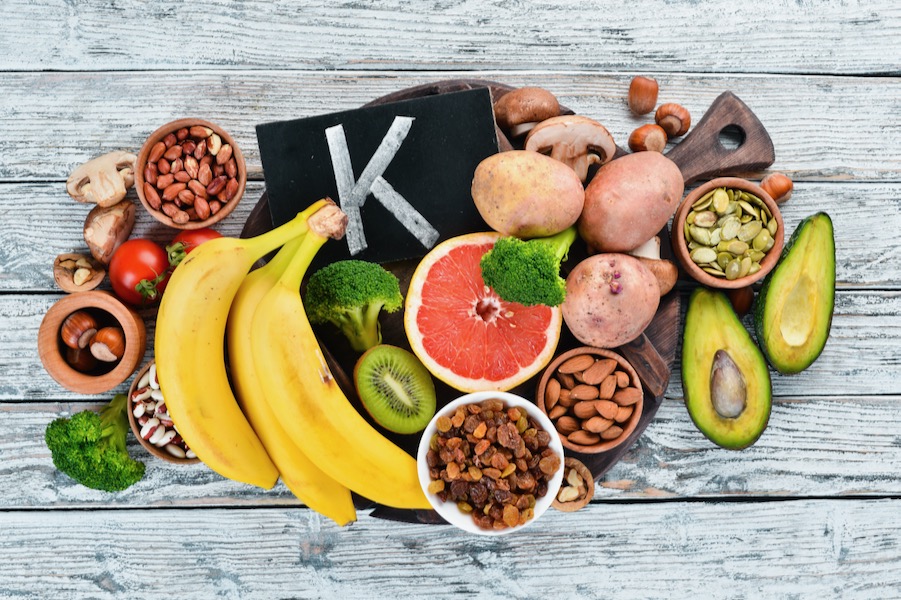Dietitian Blog, MNT Guidelines | Feb 16 2021
Potassium: Too much of a good thing?

Until recently, the Dietary Reference Intake (DRI) for potassium was 4,700 mg/day for adults.1 The Dietary Approaches to Stop Hypertension (DASH) eating plan, with its emphasis on fruits, vegetables, dairy, legumes and nuts, provides at least this amount.2 In addition to lowering blood pressure, high-potassium diets such as DASH decrease the risk of stroke, favorably impact acid-based metabolism (thereby slowing the progression of chronic kidney disease [CKD]), and may improve bone mineral density.3
Potassium primer
The average daily potassium intake in the United States is 2,640 mg/person4 – well below the previous DRI, but fairly consistent with the new DRI of 3,400 mg for men and 2,600 mg for women.1 Interestingly, the Daily Value (DV) as found on the Nutrition Facts Label is still 4,700 mg.5
Organic vs inorganic potassium
When naturally occurring in fruits and vegetables, potassium is bound to organic anions, such as citrate, which are bicarbonate precursors. The health benefits of potassium-rich foods may actually be due as much to those organic acids as to the potassium itself.6 When potassium is added to foods, which may be done to reduce a food’s sodium content, an inorganic form such as potassium chloride is generally used. Potassium additives can substantially increase a food’s potassium content. Sodium-reduced meats and poultry products have an average of 44% more potassium than the original versions, with one brand of sodium-reduced ham having 1,500 mg of potassium in a 3.5-ounce portion.7 (For comparison, meat naturally has about 420 mg in that same portion.) And low-sodium soup may contain up to 2,600 mg of potassium per single-serve can.8 Importantly, inorganic potassium may not confer the same health benefits as when it is naturally occurring and may cause hyperkalemia in certain populations.
A low-potassium diet should not be prescribed for all those in these high-risk groups; rather, its prescription should be reserved for those whose serum potassium levels are above the normal range or clearly trending up towards hyperkalemic levels.
Populations at risk for hyperkalemia
Populations at risk for hyperkalemia include the 15% of American adults (or 37 million people) with CKD,9 those with congestive heart failure (CHF) and adrenal insufficiency, and those taking certain medications (e.g., angiotensin converting enzyme [ACE] inhibitors, potassium-sparing diuretics, certain antibiotics such as sulfamethoxazole/trimethoprim [Bactrim®], and non-steroidal anti-inflammatory drugs [NSAIDs]).6 A low-potassium diet should not, however, be prescribed for all those in these high-risk groups; rather, its prescription should be reserved for those whose serum potassium levels are above the normal range or clearly trending up towards hyperkalemic levels. If serum potassium levels are normal and stable, a restriction of nourishing fruits, vegetables and other potassium-rich, alkalinizing foods is contraindicated; but, potassium levels should be closely monitored.
Nutrition facts label
The new Nutrition Facts Label includes the DV for potassium, which helps people whose goal is to either increase or decrease their potassium intake. The Food and Drug Administration permits the label to list “0%” when a food contains less than 2% of the DV per serving.5 With regard to potassium, this means that when the small (2 tablespoon) serving size of tomato-rich food (e.g., salsa) brings the potassium content to under 94 mg (i.e., less than 2% of the DV), the label is permitted to indicate 0% as the DV for potassium. RDNs must inform patients of this little-known fact to prevent their inadvertently consuming large quantities of potassium-rich foods.
Bottom line
Patients with CKD, hypertension or CHF who are hyperkalemic may very well be purchasing low-sodium versions of their favorite foods and inadvertently consuming too much potassium. It behooves RDNs to assess for intake of sodium-reduced, potassium-enriched foods and, if identified, to encourage patients to choose reduced-sodium foods that are free of potassium salts. Such a dietary modification may actually allow patients to continue enjoying moderate portions of health-promoting foods.
Dietitians On Demand is a nationwide staffing and recruiting company for registered dietitians, specializing in short-term, temporary and permanent-hire positions in acute care, long term care and food service positions. We’re dedicated to dietitians and helping them enhance their practice and excel in the workplace. Check out our job openings, request your coverage, or visit our store today!
References
National Academies of Sciences, Engineering, and Medicine 2019. Dietary Reference Intakes for Sodium and Potassium. Washington, DC: The National Academies Press. https://doi.org/10.17226/25353.
National Institutes of Health – National Heart, Lung, and Blood Institute. Your Guide to Lowering Your Blood Pressure with DASH. NIH Publication No. 06-5834, originally printed Dec 2006, revised Aug 2015. https://www.nhlbi.nih.gov/files/docs/public/heart/new_dash.pdf
Palmer BF & Clegg DJ. Achieving the Benefits of a High-Potassium, Paleolithic Diet, Without the Toxicity. Mayo Clinic Proceedings 2016;91(4):496-508. DOI: https://doi.org/10.1016/j.mayocp.2016.01.012
Hoy MK, Goldman JD. Potassium Intake of the U.S. Population: What We Eat In America, NHANES 2009- 2010. Food Surveys Research Group Dietary Data Brief No. 10. September 2012. http://ars.usda.gov/Services/docs.htm?docid=19476
S. Food and Drug Administration. Food Labeling: Revision of the Nutrition and Supplement Facts Labels. Federal Register 81(103):33894-33895. 2016. https://www.federalregister.gov/documents/2016/05/27/2016-11867/food-labeling-revision-of-the-nutrition-and-supplement-facts-labels
National Institutes of Health Office of Dietary Supplements: Potassium Fact Sheet for Health Professionals; website: https://ods.od.nih.gov/factsheets/Potassium-HealthProfessional/#h3, updated 7/9/19; accessed 2/28/20.
Parpia AS, Goldstein MB, Arcand J, et al. Sodium-reduced meat and poultry products contain a significant amount of potassium from food additives, J Acad Nutr Diet, 2018;118(5):878-885.
Gimbar M. Waiter, there’s potassium in my soup! J Ren Nutr 2018;28(4):e27-e27.
Centers for Disease Control and Prevention. Chronic Kidney Disease in the United States, 2019. Atlanta, GA: US Department of Health and Human Services, Centers for Disease Control and Prevention; 2019; website: https://www.cdc.gov/kidneydisease/publications-resources/2019-national-facts.html, updated March 2019, accessed 2/28/20
Who we are
Dietitians On Demand is the nationwide leader in providing dietitians with jobs they love. If flexibility, competitive pay, a full benefits package, free CPEUs each month and a team dedicated to dietitians sound good to you, apply to our positions today.




